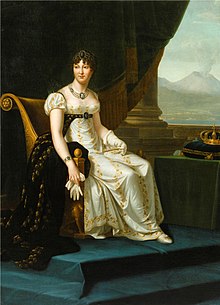|
Caroline Bonaparte
Carolina Maria Annunziata Bonaparte (French: Caroline Marie Annunciata Bonaparte; 25 March 1782 – 18 May 1839), better known as Caroline Bonaparte, was an Imperial French princess; the seventh child and third daughter of Carlo Buonaparte and Letizia Ramolino, and a younger sister of Napoleon I of France. She was queen of Naples during the reign of her spouse there, and regent of Naples during his absence four times: in 1812–1813, 1813, 1814, and 1815. In 1800, Caroline married Joachim Murat, Marshal of the Empire, Prince Murat and later King of Naples, one of Napoleon's most important and notorious generals. Early yearsThe Bonaparte family includes Joseph Bonaparte, Napoléon Bonaparte, Lucien Bonaparte, Elisa Bonaparte, Louis Bonaparte, and Pauline Bonaparte. She was an older sister of Jérôme Bonaparte. Highly regarded for her beauty and intelligence, Caroline was also complex in temperament, ambitious and politically savvy.[1]
In 1793, Caroline moved with her family to France during the French Revolution. Caroline was educated as a pupil at the school in St-Germain-en-Laye founded by Madame Jeanne Campan. She attended the school at the same time as Hortense, Joséphine's daughter and Caroline's brother Louis' wife. She fell in love with the flamboyant and charismatic Joachim Murat, one of her brother's senior cavalry commanders, and they married on 20 January 1800. Caroline was seventeen years old. Initially, Napoleon did not wish to allow them to marry, however, his wife Joséphine de Beauharnais persuaded him to change his mind.[2] When Napoleon became Emperor, she and her sisters persuaded him to make them Imperial princesses. Queen consort of NaplesCaroline became Grand Duchess of Berg and Cleves on 15 March 1806 and Queen consort of Naples on 1 August 1808, when her husband was appointed to the equivalent positions by her brother. According to the terms of the appointment, she would keep the title queen also after the death of her spouse. As queen, Caroline renovated the royal residences in Naples, had new gardens planned, encouraged the growing interest in furniture of classical design, patronized the silk and cotton industry and French artists in Naples, showed an interest in the archaeological discoveries of Pompeii and founded a school for girls. She was described as intensely jealous of her sister-in-law Joséphine and her children, reportedly because she felt Napoleon favored them over his Bonaparte relatives. It was reportedly Caroline who arranged for Napoleon to take a mistress, Éléonore Denuelle, who duly gave birth to his first illegitimate child.[3] This had the desired effect of establishing that Joséphine was infertile, as Napoleon showed he was clearly capable of siring children, which eventually resulted in his divorce from Josephine and remarriage. In 1810, when Napoleon married his second Empress Consort Marie Louise of Austria, Caroline was responsible for escorting her to France. After meeting her at the border of Austria and her duchy, Caroline forced Marie Louise to leave all her luggage, servants, and even her pet dog, behind in Austria. Caroline devoted herself to the interests of her husband Joachim Murat, the King of Naples, where she was very much involved in the affairs of the Kingdom. As queen of Naples, she functioned as the regent of Naples during the absence of Joachim on four occasions: during his participation in the war on Russia in 1812–1813, during his participation in the war in Germany in 1813, during the war against Napoleon in 1814, and, finally, during the return of Napoleon to power in 1815. In 1814, she supported his decision to make a separate peace with the anti-Napoleonic allies, keeping his throne while Napoleon was deposed.[4] Then, during the Hundred Days of 1815, Joachim came out for Napoleon. During his absence, Caroline was left as regent of Naples. Joachim was defeated and executed, and Caroline fled to the Austrian Empire. Whilst in exile, she adopted the title 'Countess of Lipona'; 'Lipona' being an anagram of 'Napoli' (Naples). DeathAfter her husband's death she lived in Florence until her death in 1839. Caroline was buried at the Chiesa di Ognissanti, in Florence. IssueCaroline and Joachim were the parents of four children:
Gallery
Notes and referencesWikimedia Commons has media related to Caroline Bonaparte.
Further reading
|
||||||||||||||||||||||||||||||||||||||||












